Condensate on pipes: causes and methods of struggle
Each of us certainly faced the problem of moisture settling on the pipeline in the house. And if there is condensation on the pipes - not everyone knows how to deal with it. Moreover, it can occur in bathrooms or toilets, boiler rooms, basements, as well as other rooms where there is a difference in the temperatures of water flowing in pipes and the environment.
As a result, metal pipes are exposed to corrosion, and plastic - overgrown with unattractive black bloom, which is a mold, which can cause allergic reactions in some people.
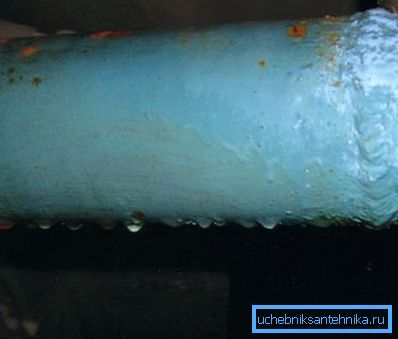
Causes of condensation
Condensate on a cold water pipe can form for a number of reasons. The first thing to check is whether ventilation works well (see also the article Butt-welding: technology and equipment).
Due to its clogging, the air circulation in the room is disturbed. To check this, simply leave the toilet door open for a few hours.
Note! The inspection should be carried out at night when there is no movement of water through the pipes. If in the morning you find that the upper part of the pipes has dried, then the problem is clearly a bad exhaust.
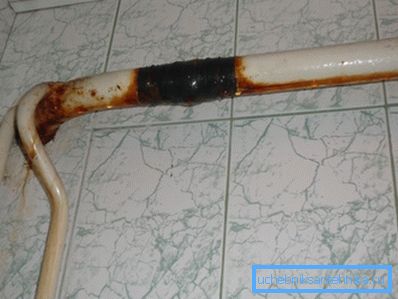
| Causes of condensate | |
| Condensate in the toilet. | The cause may be the leakage of the tank. In order to get rid of this phenomenon, you should check the tank inlet valve. |
| In the toilet mist riser. | This may indicate a leakage of water in neighboring apartments, so here you will have to contact the neighbors. In the meantime, accidents are eliminated, wind a strip of cotton fabric on the pipe, lowering its end into any container. |
| The formation of moisture on the pipes of the apartment wiring. | The problem may lie in both poor ventilation and a malfunctioning plumbing fixture. |
| Condensate in new buildings. | Some new buildings have a feature - ventilation does not function if the windows are closed. You can check this by putting a newspaper to the exhaust opening with the windows open and closed. |
We clean the condensate in the bathroom
Before you get rid of the condensate on the pipes in the bathroom, it is necessary to determine the cause of its formation.
There can be several reasons:
- The riser pipe gets wet - it means you need to rise to the neighbors from above, most likely they have a leak.
- The wetting of the pipe going to the plumbing fixture is a consequence of a malfunctioning tap.
- If the problem is inadequate ventilation, then it is necessary to eliminate the blockage that has formed in the exhaust port.
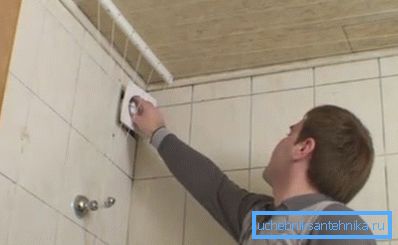
If all of the above options do not apply to your case, then what to do with condensation on cold water pipes? The occurrence of excess humidity is associated with a significant temperature difference between the pipe with cold water and the warm air of the room. Only heat insulation can solve this problem.
Special insulating materials are sold in construction stores and hypermarkets and are covers that are worn on problem areas.
The works are carried out in several stages, for which there is a simple instruction:
- We select a heat insulator whose diameter is slightly larger than the diameter of the pipe.
- Cut the insulating material into segments, depending on the length of the pipe.
- Dress pieces on the pipe so that the cut was at the bottom.
- Tubular space is filled with polyurethane foam.
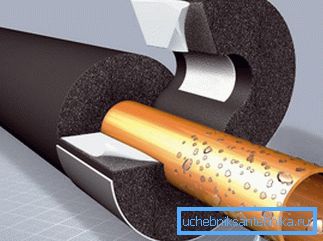
Improvised insulation
The above option to protect pipes from condensate is not the only one, because the heat-insulating casing can be made by hand.
For this you will need:
- Sanding paper.
- Acetone.
- Thick durable thread.
- Epoxy putty.
- The fabric is cut into strips, about 5 cm wide.
- Putty knife.
- Rust converter (excellent phosphoric acid).
Now we will consider how to eliminate condensate on water pipes:
- We sand the pipe in order to ensure high-quality adhesion with the insulating material.
- Dampen a cloth with acetone, wipe the surface in order to achieve its degreasing.
- We treat the surface with orthophosphoric acid, which will provide protection against rust.
- After the pipe dries, it is necessary to cover it with a layer of epoxy putty. On a consistence it should remind a thick paint and not flow down.
- Now quickly, in order to prevent the hardening of the putty, we wind the pipe with strips of cloth. This should be done with good tension, making sure that the fabric fits snugly to the pipe over the entire area.
Note! As a heater, you can use the mineral wool, which is wrapped around the pipe, fixing the metal clamps. This method is often used in industrial environments.
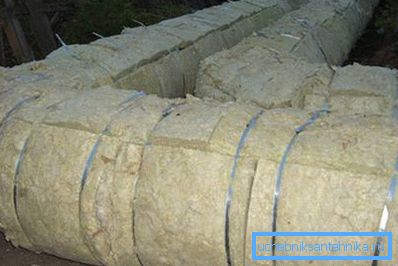
- We tie up the last turn of the fabric with a strong thread.
This method is known for more than a dozen years and is very effective. Its only drawback is the not very attractive appearance of such insulation.
Reducing condensate on the gas boiler pipe
Condensate on the gas boiler tube is a fairly common phenomenon. Remove it completely fail, but to reduce its detrimental effect on the chimney allows thermal insulation. Insulation is carried out especially in the upper part of the chimney, which reduces its cooling.
Note! The best heat insulator for chimneys are sandwich pipes. Their outer walls are an excellent insulating material.
The sandwich pipe consists of an internal and external circuit, between which there is an insulating layer. The inner contour is a chimney, on which a metal casing with a sheet heat insulator in the form of stone wool is placed on it.
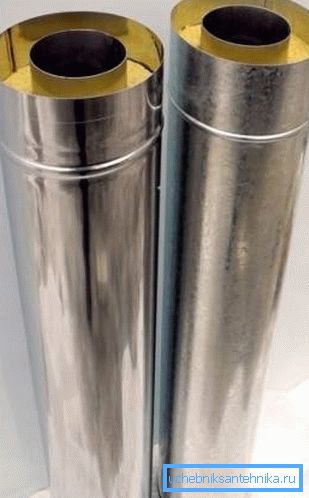
If you are not satisfied with the price of factory sandwiches, then you can make their analogs yourself:
- In order to reduce condensate in the chimney pipe, you will need galvanized iron and stone wool.
- Wrap the inner tube with strips of stone wool.
- Top mount galvanized. The outer shell is usually made of several pieces, so special attention should be paid to their docking with each other. Galvanized iron is fixed by means of flea or self-tapping screws.
By making the removal of condensate from the chimney, you can take a variety of materials, which is directly dependent on the fuel device. For example, industrial production boilers have a relatively low temperature of exhaust gases (up to 120 degrees Celsius), therefore, mineral wool can be purchased as a heater for them.
Condensation on the gas pipe of a solid fuel boiler, an improvised stove or fireplace is eliminated only with the use of stone wool, since the temperature here can reach 700 degrees. In such devices, a thick-walled inner tube should be installed, otherwise the risk of rapid burnout increases.
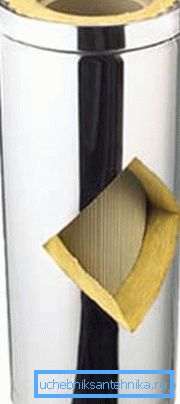
Conclusion
Condensate is the main cause of the destructive processes that occur in pipes. And if it is not eliminated, then soon you may need a serious repair of the water and gas supply system. From the video in this article you can find out more information about the options and methods for eliminating excessive moisture in the pipeline in your home (also read the article Spikes in pipes: installation and necessary equipment).
So, if there is condensation on the pipes, you now know how to solve the problem. As an additional measure to eliminate this unpleasant phenomenon, you can use a moisture absorber.
You can also install a powerful air conditioner that will control the level of humidity in the room. But this method is probably the most expensive.